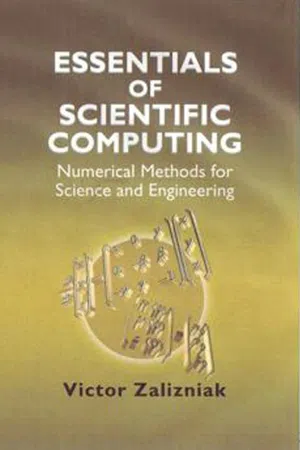
Essentials of Scientific Computing
Numerical Methods for Science and Engineering
- 212 pages
- English
- ePUB (mobile friendly)
- Available on iOS & Android
About This Book
Modern development of science and technology is based to a large degree on computer modelling. To understand the principles and techniques of computer modelling, students should first get a strong background in classical numerical methods, which are the subject of this book. This text is intended for use in a numerical methods course for engineering and science students, but will also be useful as a handbook on numerical techniques for research students.Essentials of Scientific Computing is as self-contained as possible and considers a variety of methods for each type of problem discussed. It covers the basic ideas of numerical techniques, including iterative process, extrapolation and matrix factorization, and practical implementation of the methods shown is explained through numerous examples. An introduction to MATLAB is included, together with a brief overview of modern software widely used in scientific computations.
- Outlines classical numerical methods, which is essential for understanding the principles and techniques of computer modelling
- Intended for use in a numerical methods course for engineering and science students, but will also be useful as a handbook on numerical techniques for research students
- Covers the basic ideas of numerical techniques, including iterative process, extrapolation and matrix factorization
Frequently asked questions
Information
Errors in computer arithmetic operations



Table of contents
- Cover image
- Title page
- Table of Contents
- Copyright page
- About the Author
- Dedication
- List of Examples
- Preface
- 1: Errors in computer arithmetic operations
- 2: Solving equations of the form f(x)=0
- 3: Solving systems of linear equations
- 4: Computational eigenvalue problems
- 5: Solving systems of nonlinear equations
- 6: Numerical integration
- 7: Introduction to finite difference schemes for ordinary differential equations
- 8: Interpolation and Approximation
- 9: Programming in MATLAB
- A: Integration formulae of Gaussian type
- B: Transformations of integration domains
- C: Stability regions for Runge-Kutta and Adams schemes
- D: A brief survey of available software
- Bibliography
- Index